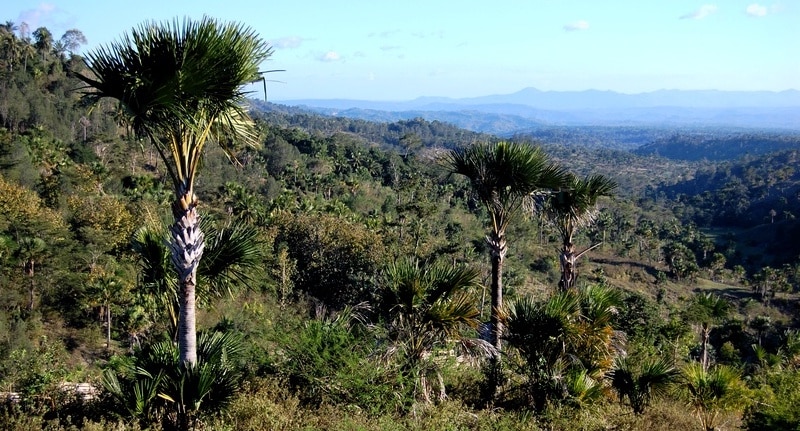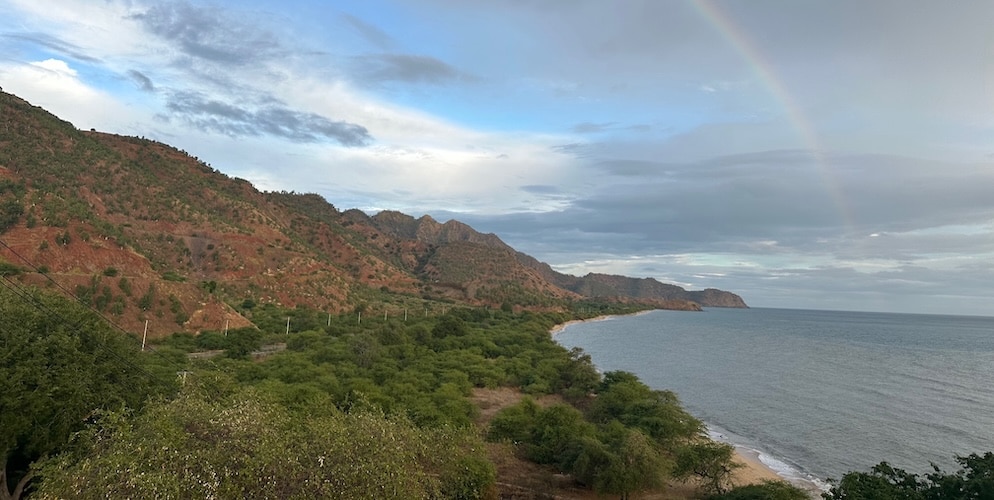Democratic Republic of Timor-Leste

Timor-Leste aka East Timor is a country in Southeast Asia. It comprises the eastern half of the island of Timor and the nearby islands of Atauro & Jaco, and Oecussi-Ambeno and an exclave on the northwestern side of the island, within Indonesian West Timor. The small country of 15,410 km² (5,400 square miles) is located about 640 km (400 miles) northwest of Darwin, Australia. It has a population approaching 1.5 million, a quarter of a million of whom live in Dili, its capital and largest city, which is on the north coast. The local climate is tropical and generally hot and humid, characterised by distinct rainy and dry seasons. Most rivers dry up at least partially during the dry season. Temperatures are relatively stable throughout the year. The wet season lasts from December to May throughout the country, and lasts slightly longer in the south and the interior due to the effect of a monsoon from Australia. The country is vulnerable to flooding and landslides that occur as a result of heavy rain, especially when rainfall levels are increased by La Niña effect.
Located in southeast Asia, the island of Timor is part of the Malay Archipelago, and is the largest and easternmost of the Lesser Sunda Islands, As such, Timor forms part of the Wallacea region, the boundary region between Asia and Oceania. To the north of the mountainous island are the Ombai Strait, Wetar Strait and the greater Banda Sea, to the south the Timor Sea separates the island from Australia, while to the west lies the Indonesian Province of East Nusa Tenggara. The highest point of East Timor is Mount Ramelau (also known as Mount Tatamailau) at just under 3,000 meters (9,750 feet) and almost half of the country has a slope of at least 40%.

Hilly Savana ©Wibowo Djatmiko
Outside of some coastal areas and river valleys, the soil is shallow and prone to erosion, and its quality is poor. Timor-Leste is a poor country with two thirds of the population relying on subsistence farming or fishing.
Birding Timor-Leste
The easternmost area of Timor-Leste consists of the Paitchau Range and Iralalaro area. Nono Konis Santana National Park is the first conservation area in Timor-Leste, designated as it contains the last remaining Tropical Dry forested area within the country as well as hosting a number of unique plant and animal species, as well as being sparsely populated. The p[ark also encompasses over 550 K² of the ‘coral triangle’ an underwater area that may contain the world’s greatest density of coral and reef fish species. The Northern coast is characterised by a number of important coral reef systems that have been determined as being at risk. Sea life abounds with literally hundreds of fish species.

Dili District – ©Bird-Photo-Tours ASIA
East Timor’s fauna is diverse and contains a number of endemic and threatened species. The Timor and Wetar deciduous forests region, which covers the entire island, has 38 mammal species. East Timor’s terrestrial biodiversity is most visible in its 289 native bird species with a number endemic to the island as a whole.
-
Wikipedia
GNU Free Documentation License
http://en.wikipedia.org/wiki/East_Timor
-
Number of bird species: 289
(As at April 2024)
Number of endemics: 8
There are no birds endemic to Timore-Leste. However, according to BirdLife 8 species are endemic to the island of Timor as a whole:
Timor Boobook Ninox fusca
Flame-eared Honeyeater Lichmera flavicans
Timor Friarbird Philemon inornatus
Black-breasted Myzomela Myzomela vulnerata
Streak-breasted Honeyeater Microptilotis reticulatus
Buff-banded Bushbird Buettikoferella bivittate
Timor White-eye Heleia muelleri
Black-banded Flycatcher Ficedula timorensis
Number of endemics: 5
...and five others on Timor and its archpelago of Rote and Semau Islands:
Timor Oriole Oriolus melanotis
Timor Green-pigeon Treron psittaceus
Timor Figbird Sphecotheres viridis
White-bellied Bushchat Saxicola gutturalis
Timor Sparrow Lonchura fuscata
-
Avibase
PDF ChecklistIsland of Timor -
Avibase
PDF ChecklistThis checklist includes all bird species found in Timor-Leste , based on the best information available at this time. It is based on a wide variety of sources that I collated over many years. I am pleased to offer these checklists as a service to birdwatchers. -
Wikipedia
Annotated ListThis is a list of the bird species recorded in East Timor. The avifauna of East Timor include a total of 289 species.
-
Birds of the Philippines, Sumatra, Java, Bali, Borneo, Sulawesi, the Lesser Sundas and the Moluccas
| By Norman Arlott | William Collins | 2018 | Hardback | 416 pages, 179 plates with colour illustrations; colour distribution maps | ISBN: 9780008102395 Buy this book from NHBS.com -
Important Bird Areas in Timor-Leste
| (Key Sites for Conservation) | by Michael J Crosby | BirdLife International | 2007 | Paperback | 86 pages, tables, colour photos, maps | ISBN: 9780946888597 Buy this book from NHBS.com
-
NP IBA WII Tasitolu Peace Park
InformationSatellite ViewTimor Leste's Peace Park is their first designated National Park and an Important Bird Area [IBA] that accommodates several near-threatened species. . Tasitolu translates as 'three waters' and is a protected area on the coast of East Timor, 8 kilometres (5.0 mi) west of the capital Dili. The Tasitolu wetlands include three saline lakes, an esplanade, and a beach; it has been designated a Wetland of National Significance. -
NP Nino Konis Santana
InformationSatellite ViewThe Nino Konis Santana National Park was East Timor's first national park. It covers 1,236 square kilometres (477 square miles). It links important bird areas such as Lore, Mount Paitchau, Lake Ira Lalaro, and Jaco Island. The park also includes 556 square kilometres (215 square miles) of the Coral Triangle, an underwater area which supposedly contains the world's greatest diversity of both coral and coral reef fish. Some of the rare birds protected by this park are the critically endangered yellow-crested cockatoo, the endemic Timor green-pigeon, the endangered Timor imperial-pigeon, and the vulnerable Timor sparrow.
-
Bird Photo Tours ASIA
Tour OperatorTimor-Leste is one of the newest countries in the world having won independence from Indonesia in 2002 and of particular interest to the bird photographer is its 240 bird species, 13 near-endemics, pristine habitats and limited population which means many of its habitats are undisturbed.
-
2013 [07 July] - Petri Hottola
PDF ReportI did my birdwatching along the north coast road, east of Los Palos (Muapitine, Malahara) and in Ossu (Mundo Perdido). Here are the details of the sites… -
2013 [11 November] - James Eaton
PDF Report…A short stop in the heat of the day at a beautiful roadside pond revealed plenty of breeding and feeding activity – several pairs of Australian Grebes were busy feeding their well-grown young, Dusky Moorhen lurked in the shadows while Green Pygmy Geese (a tarts tick for James!) lounged out on the floating logs with several Pied Cormorants and a single Australian Darter… -
2015 [08 August] -
Report...We spent the rest of the morning walking a track in the area where we found Pygmy Wren Babbler, Island Thrush, a family party of the newly discovered parrotfinch, Snowy-browed Flycatcher and our only Sunda Bush Warbler... -
2022 [07 July] - Andy Walker - Lesser Sundas
PDF ReportThe list of highlights was very long and included Flores Scops Owl, Sumba Boobook, Little Sumba Hawk-Owl, Rote Boobook, Timor Boobook, Flores Hawk-Eagle, Sumba Hornbill, Yellow-crested Cockatoo, Elegant Pitta, Ornate Pitta, Red-naped Fruit Dove, Timor Imperial Pigeon, Timor Cuckoo-Dove, Bare-throated Whistler, Buff-banded Thicketbird, Flores Monarch, Little (Flores) Minivet, Rote Leaf Warbler, Timor Leaf Warbler, Flores Leaf Warbler, White-browed (Flores) Shortwing, Black-banded Flycatcher, Timor Blue Flycatcher, Sumba Myzomela, Rote Myzomela, Black-breasted (Timor) Myzomela, Alor Myzomela, and Timor Sparrow. Non-avian highlight was easily Komodo Dragon!


